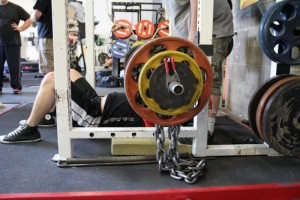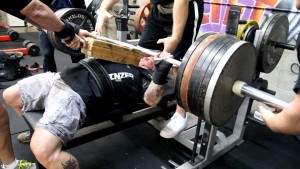By Jesse Burdick
I want to tell you some things about where motivation comes from. Six years ago, my life changed dramatically with the birth of my baby girls, Kaycie and Sophia. When these two came on the scene, I wasn’t able to do all the things I’d been doing on a daily basis for years until that point.
I’m still a competitive powerlifter, but back then, it was my entire life. I belonged to a gym about a half hour away from where I lived—which, if you do the math, requires a return trip of a half hour, too. I’d commute, squat for two or three hours, then drive home. When my girls were born, this wasn’t feasible anymore, so I ended up training in my garage—where things, both with my mindset and my goals—had to change.
The Insomniac
For the first two months or so after Kaycie and Sophia were born, I averaged about two hours of sleep per night. I realize that some people deal with this every night for whatever reason—and I’m not complaining about it—but it was a major change for me. I tried to keep everything moving with my powerlifting career, but something had to give—especially when, because of a variety of circumstances, I was eventually raising the girls on my own. As a result, I ended up permanently leaving the powerlifting gym I’d belonged to for several years.
At that point, I was alone. I had my own gym to train in, but I didn’t have any training partners, which is important to me. I tried to get people in to train with me and cultivate them as partners, but that’s a lot easier said than done.
I eventually took a long, hard look at my situation and came to the understanding that, given my situation, I wasn’t going to get any stronger as a geared powerlifter. The idea, then, was to figure out what I could do to keep myself interested. If I wasn’t going to be training hard with some concrete goal in mind, things were going to be very difficult for me. What could I do? What were my new goals going to be? How could I make everything fun despite these “limitations”?
Hitting the Reset Button
 So, there I was, a single dad with two kids, working fifty hours a week and trying to figure out where to fit in my training time—and also what, exactly, I was training for. Around that time, I read an article about Westside Barbell’s Louie Simmons, and how he was one of the few people in history to have recorded an elite powerlifting total in five different weight classes. At the time, I had elite totals in three classes: 242, 275, and 308 pounds.
So, there I was, a single dad with two kids, working fifty hours a week and trying to figure out where to fit in my training time—and also what, exactly, I was training for. Around that time, I read an article about Westside Barbell’s Louie Simmons, and how he was one of the few people in history to have recorded an elite powerlifting total in five different weight classes. At the time, I had elite totals in three classes: 242, 275, and 308 pounds.
The wheels began to turn. I weighed about 280 pounds, so I thought a worthy goal would be to drop sixty pounds and go after an elite total in a lower weight class. This would give me two goals to chase at the same time: Shedding a load of weight, while still training to get stronger.
A Little Help?
That’s when I met Kiefer. I told him what I wanted to do, which entailed first dropping from 280 to 220 pounds and getting my elite total there—then moving up to superheavyweight and doing the same thing. I also wanted to do this within the span of one calendar year. Kiefer was intrigued, and he said, “I’d definitely like to help you. Let’s talk, and we’ll figure out a program to get you going.”
What you need to understand about my goals here is that they were realistic. That’s one major concept I’m trying to get across. When you’re reassessing and reevaluating—after a major life change, or when you’re first getting back into the gym—you need to take a realistic look at your life and see exactly what it is that you can expect to accomplish.
Training to be a geared powerlifter takes a lot of time every day. That’s just the way the sport works. If you don’t have a few hours every day to spend in your gear, you’re not going to be very competitive. There are very few people in the world who can train raw all the time, then just slap on their gear for a meet without having figured out how to use it. It doesn’t happen that way.
Modesty is the Best Policy
This is why, if you’re a 500 pound squatter, you shouldn’t be thinking in terms of pie-in-the-sky goals like squatting a thousand pounds. It’s awesome if that’s your long-term plan, but it’s going to take years, and if you don’t have the time to dedicate on a daily basis, it’s not something that should be on your immediate list of goals. Keep it at the end of the list, but in the meantime, you have to give yourself smaller goals in order to make sure you’re staying on course to hit that ultimate big goal.
 Whenever I start working with a new client, the first thing I’ll do is sit down with them and do this kind of realistic assessment. I’ll ask them several personal questions: What do you do for a living? What’s your family situation? What kind of stresses are you under every day? That’s the stuff that’s going to dictate what you’ll be able to handle—and that’s where you need to start with this process of setting goals.
Whenever I start working with a new client, the first thing I’ll do is sit down with them and do this kind of realistic assessment. I’ll ask them several personal questions: What do you do for a living? What’s your family situation? What kind of stresses are you under every day? That’s the stuff that’s going to dictate what you’ll be able to handle—and that’s where you need to start with this process of setting goals.
Where does all of this fit into your life? If you’ve only got five hours each week to spend in the gym, you have to figure out what you can do with those five hours, and maximize your time. Do you work in some crazy profession where you’re only sleeping four hours per night and you’re always under a tremendous amount of stress? You have to factor that in and learn how to manage it before you start setting crazy goals you’ll never be able to reach.
Small is Good
It’s a very hard thing to do to take a look at your current situation and say, “I can’t do this right now.” Maybe you’ll be able to work toward squatting a thousand pounds eventually, but when you don’t have the time or the energy to devote to it, you can’t do it right now. For me, during the period after my girls were born, training in powerlifting gear for hours every day just wasn’t going to happen. I didn’t have the time, the equipment, or the training partners to make it happen.
As a result, I had to wrap my head around working with Kiefer to figure out how to make things work for me—with a combination of The Carb Nite Solution and setting small, realistic goals in the gym.
This will accomplish good things for you, though. When you find something you know you can do, and you work toward it and get it done, there are few feelings in life that can match that fulfillment. That feeling breeds success, and it makes you want to do more. It’ll keep you committed, on track, and ready to set that next goal—whether we’re talking short-term, mid-term, or long-term. That’s what working with Kiefer and cutting all that weight did for me. I knew I could do it, I did it, and it made me that much hungrier for the next thing.
Recalibration
When I lost all the weight I did, I had to understand that my personal records (PRs) no longer applied. You can’t get all pissed off about not hitting a PR when your PRs were originally set when you were sixty pounds heavier. This is a humbling experience, but this sort of recalibration is the only way you’re ever going to come to terms with your new goals.
 One way to make this process go more smoothly is to try something Mark Bell calls “underloading”—where you’re trying a new lift without knowing precisely how much weight is on the bar. Let’s say you’re doing something like a deficit deadlift, with 315 pounds and three or four chains on the bar. You do this for five reps, and that’s hard for you. Guess what, though? You’ve gotten your work in, and it’s a PR.
One way to make this process go more smoothly is to try something Mark Bell calls “underloading”—where you’re trying a new lift without knowing precisely how much weight is on the bar. Let’s say you’re doing something like a deficit deadlift, with 315 pounds and three or four chains on the bar. You do this for five reps, and that’s hard for you. Guess what, though? You’ve gotten your work in, and it’s a PR.
This may be hard to conceptualize, but since it’s something you’ve never done before, it’s a record. A baseline. All you know is that it’s heavy, it made you breathe hard, and you worked. That’s a win for that day, and it’s another goal for next week. When it’s recalibration time like this, stay away from things where you’ve already maxed out your numbers—this applies to life as well as lifting—and get some solid work in elsewhere.
Your Daily Attitude
The ability to walk into a gym every day and train hard is a privilege, and you should treat it that way. Be fired up to train every day. Go to the gym and get excited. Know the difference between “getting excited” and slamming your face into the bar until you bleed because you saw someone make it look hardcore on YouTube. Just train happy. If going to the gym and lifting heavy is your hobby, then that’s a damned cool thing.
If you watch me train, or you train with our group, we’re always cracking jokes, having fun, and smiling. When I finish a hard set, I’ll say something like, “Holy shit, that sucked. That was horrible!” I have fun with training. It’s my release, and it’s one of the things I enjoy most in life, so I can’t understand the notion of going to the gym and not having fun.
Now, in competition, I’ll get fired up and lose my mind a little bit—and people will ask me how I can “turn it on” the way I do. Thing is, it’s not turning it on that’s difficult for me. It’s turning it off.
Think about what I mean by this. If I need to slam my head against the wall and slap myself silly to set a PR on some lift, chances are I have to turn around in a half hour and pick my kids up from kindergarten. There, I have to interact with other parents, and I have to talk to my girls’ teacher. The problem there isn’t turning it on, obviously. It’s turning it off so I can function like a responsible adult without inappropriately foaming at the mouth and scaring the hell out a bunch of five-year-olds.
The Training Psyche
At my gym, I let everyone else control the music. If you’re a guy who needs that one special Slayer song to squat to, and you wait until it hits some big crescendo to get under the bar, that’s okay, but what are you going to do when you’re not in control? What happens when you don’t have your own perfectly optimal conditions in which to train? Will you be able to perform? Can you always replicate your own perfect conditions?
 I always train for the worst possible scenarios. I’ll bench and deadlift with the worst bar in the gym. I’m always trying to screw things up and make my conditions less-than-optimal, because when things really are perfect, and I’m using one of those fancy bars, it’s going to make a big difference when it counts. For me, my meets are what counts—not my gym lifts.
I always train for the worst possible scenarios. I’ll bench and deadlift with the worst bar in the gym. I’m always trying to screw things up and make my conditions less-than-optimal, because when things really are perfect, and I’m using one of those fancy bars, it’s going to make a big difference when it counts. For me, my meets are what counts—not my gym lifts.
When all else fails, talk it out with someone. I give my number to all of my clients, and I’ll tell people to text me whenever they need something. If they’re having a bad day, and they want to blow it—whether that means skipping a session or taking a cheat meal two days early—we’ll talk through things and figure it out.
You can do that for yourself with your own support system. This can be a friend, a significant other, or a coach, if you have one, and it makes a huge difference. You’re stressed? So what. So is everyone else. Get used to it. Talk to someone who can remind you of your priorities and help you realize that today is no different from yesterday—when you had everything together—and that you can deal with it and power through.
There’s your mindset. Now set your goals and go to work.








Recent Comments